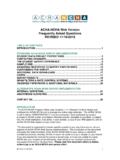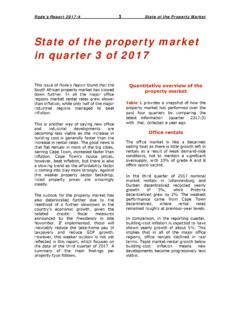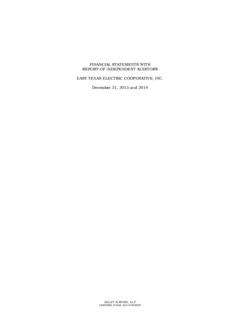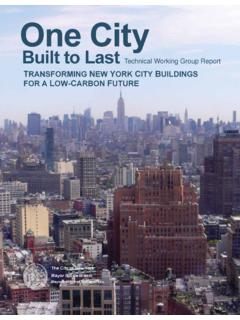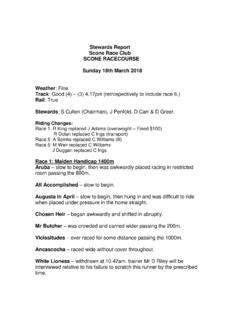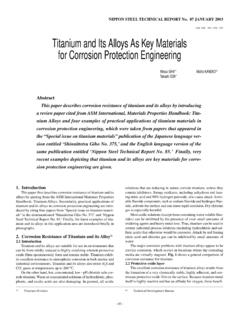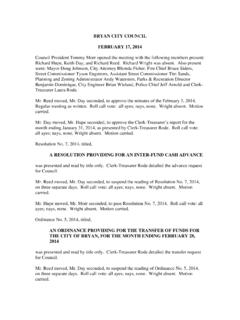Transcription of Spring 2015 Reference Group Executive Summary
1 Spring 2015 Reference Group Executive SummaryTable of ContentsI. Introduction2II. FindingsA. General Health of College Students3B. Disease and Injury Prevention4C. Academic Impacts5D. Violence, Abusive Relationships and Personal Safety5E. Alcohol, Tobacco, and Other Drug Use6F. Sexual Behavior10G. Nutrition and Exercise12H. Mental Health13I. Sleep16 III. Demographics and Student Characteristics 17IV. Demographics of Participating Institutions18 Suggested citation for this document: American College Health Association. American College Health Association-National College Health Assessment II: Reference Group Executive Summary Spring 2015.
2 Hanover, MD: American College Health Association; 2015. ACHA, the nation's principal advocate and leadership organization for college and university health, represents a diverse membership that provides and supports the delivery of health care and prevention and wellness services for the nation's 20 million college students. For more information about the association's programs and services, visit , and on use of data:The overall response proportion was The ACHA-National College Health Assessment II (ACHA-NCHA II) is a national research survey organized by the American College Health Association (ACHA) to assist college health service providers, health educators, counselors, and administrators in collecting data about their students' habits, behaviors, and perceptions on the most prevalent health initiated the original ACHA-NCHA in 2000 and the instrument was used nation wide through the Spring 2008 data collection period.
3 The ACHA-NCHA now provides the largest known comprehensive data set on the health of college students, providing the college health and higher education fields with a vast spectrum of information on student revised survey, the ACHA-NCHA-II, was developed following a thorough pilot testing process. Although the general categories of information for which data are collected remain the same between the original ACHA-NCHA and this revised survey, a number of questions have been modified, and new questions have been added to monitor a variety of health constructs. Specific revisions include updated lists of illegal drugs, contraceptive methods, and vaccines.
4 New items have been added to capture sleep behaviors, self-injury, the use/abuse of prescription drugs and additional mental health additional information about the survey s development, design, and methodology, email Mary Hoban, PhD, CHES, E. Victor Leino, PhD or visit values have been excluded from analysis. Students responding "not applicable" were excluded from several analyses, which are specifically noted throughout this document. All response categories were included, including "don't know" or "0" unless otherwise for a Reference Group consisting of 93,034 note the ACHA-NCHA II is not appropriate for trend comparison of items from the original ACHA-NCHA survey.
5 A new baseline for ACHA-NCHA II began in the fall of 2008. Directly comparing pre- and post-redesign estimates on similar data points, without taking into account the impact of the survey s redesign, might lead to an erroneous conclusion. Documentation regarding the results of the pilot study and differences between the instruments can be obtained at the ACHA-NCHA website, This Executive Summary highlights results of the ACHA-NCHA II Spring 2015 FindingsA. General Health of College % of college students surveyed ( % male % female) describedtheir health as very good or % male % female) describedtheir health as good, very good or of college students who reported being diagnosed or treated by a professional for any of the following health problems within the last 12 months.
6 %Hepatitis B or % %High blood %Back %High %Broken bone/Fracture/ %HIV % %Irritable Bowel % %Migraine % % %Ear %Pelvic Inflammatory % %Repetitive stress %Genital %Sinus %Genital warts/ %Strep % % %Urinary tract % % of college students ( male, % female) reported being diagnosed or treated by a professional with one or more of the above conditions within the last 12 of college students who reported any of the following:Attention Deficit and Hyperactivity Disorder (ADHD) %Chronic illness ( , cancer, diabetes, auto-immune disorders) %Deafness/Hearing %Learning %Mobility/Dexterity %Partial %Psychiatric %Speech or language %Other %3 % of college students surveyed (Findings continuedB.)
7 Disease and Injury PreventionCollege students reported receiving the following vaccinations (shots) % reported receiving vaccination against hepatitis % reported receiving vaccination against Human Papillomavirus/HPV (cervical cancer vaccine). % reported receiving vaccination against influenza (flu) in the last 12 months (shot or nasal mist). % reported receiving vaccination against measles, mumps, % reported receiving vaccination against meningococcal % reported receiving vaccination against varicella (chicken pox).Other disease prevention practices reported by college % reported having a dental exam and cleaning in the last 12 months.
8 % of males reported performing a testicular self exam in the last 30 % of females reported performing a breast self exam in the last 30 % of females reported having a routine gynecological exam in the last 12 % reported using sunscreen regularly with sun % reported ever being tested for Human Immunodeficiency Virus (HIV) students reported the following behaviors within the last 12 months:4 Wear a helmet when you rode a * Students responding "N/A, did not do this activity within the last 12 months" were a helmet when you were inline or always* Percent (%)Rarely or sometimes* *N/A, did not do this activity within the last 12 a seatbelt when you rode in a a helmet when you rode a continuedC.
9 Academic Impactsacademic performance, defined as: received a lower grade on an exam, or an important project; received a lower grade in the course; received an incomplete or dropped the course; or experienced a significant disruption in thesis, dissertation, research, or practicum work; (listed alphabetically):Alcohol % % % % % %Assault (physical) %Internet use/computer (sexual) %Learning %Attention Deficit/Hyperactivity Disorder: %Participation in extracurricular Cold/Flu/Sore % activities: %Concern for a troubled friend Pregnancy (yours or partner's) or family %Relationship %Chronic health problem or serious %Roommate %Chronic %Sexually transmitted disease/ Death of a friend or family % infection (STD/I) % %Sinus infection/Ear infection/Discrimination: % Bronchitis/Strep %Drug %Sleep %Eating disorder/ % % % % %D.
10 Violence, Abusive Relationships and Personal SafetyWithin the last 12 months, college students reported experiencing:Percent (%)MaleFemale TotalA physical physical assault (not sexual assault) verbal touching without their penetration attempt without their penetration without their emotionally abusive intimate physically abusive intimate sexually abusive intimate the last 12 months, students reported the following factors affecting their individualFindings continuedCollege students reported feeling very safe:Percent (%)MaleFemale TotalOn their campus (daytime) their campus (nighttime) the community surrounding their school (daytime) the community surrounding their school (nighttime) Alcohol, Tobacco, and Other Drug UseReported use versus perceived use - reported use for all students within the past 30 dayscompared with how often students perceived the typical student on campus used substances within the same time period.





